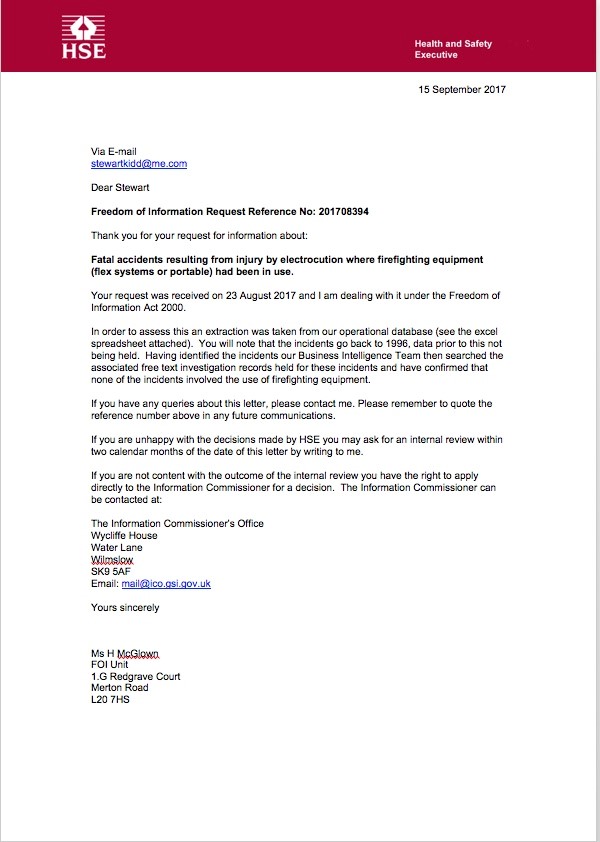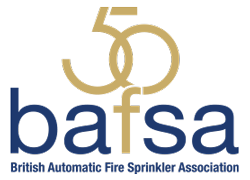Discussions with architects, developers and others as well as main contractors when discussing areas of a sprinklered building frequency relate to areas where sprinkler protection can be omitted. One concern often raised is the possibility of injury or damage when sprinkler protection is installed in electrical utility rooms. The forthcoming iteration of BS 5306 Part 0 contains advice on the interactions between electricity ad fire suppression systems including hose reels and portable fire extinguishers. The text quotes from an article published in the November 2018 issue of Fire Risk Management, the journal of the Fire Protection Association:
Concerns about the dangers of using water fire extinguishers or hose reels to extinguish fires in live electrical equipment usually relate to the possible risks of electrocution. This theoretical risk (the HSE have not recorded any such actual injuries) probably originates in tests undertaken by the Paris fire brigade in the 1930s and replicated in a piece of demonstration equipment at the Fire Service College.
Using a 9 l water extinguisher generating a straight jet could endanger the user if the jet were to come into contact with a live conductor, as there is the possibility that electricity could be conducted back upstream to the person holding the extinguisher, especially if they are standing on a wet floor. Because of this risk, the conventional approach at the time of publication of this part of BS 5306 is to omit sprinkler protection in plant rooms and to provide dry powder and/or carbon dioxide portables adjacent to electrical equipment.
Portable fire extinguishers using water mist have been available in the UK for a number of years, but do not appear to have been widely promoted. Apart from their widespread effectiveness, they have a major advantage in that they have a high level of dielectric safety.
A number of manufacturers of portable water mist fire extinguishers on the market in the UK state that their product has passed a 35 kV test.
There have been several instances where fires have started in server rooms but have been extinguished by a single sprinkler head, preventing any fire spread from the room of origin. At the time of publication of this part of BS 5306, the standards for sprinklers and water mist systems allow these to be omitted in “areas or rooms where water discharge might present a hazard”. For sprinklers in particular, BS EN 12845:2015, 5.1.3c) is used based systems to be subject to a risk assessment where their use is proposed in areas where electrical risks are present.
Where wet systems are clearly unacceptable because of the risk to personal safety or collateral damage to property, it has been normal practice to install inert or chemical gas flooding systems where automatic fire suppression is essential.
With regard to water-based systems in general, power generation companies make extensive use of water-based fire suppression equipment to protect turbo-alternators, switch gear and transformers at voltages up to 400 kV and involving significant currents (typically 20 000 MVA). Provided that such systems are designed and installed in accordance with the appropriate standards, it is expected that they will function as designed. to justify omission of coverage in switch rooms, server rooms and transformer chambers.
In view of the uncertainty discussed above, it is advisable for water-
In an article in the FPA magazine, FRM (November 2017), former BAFSA secretary general Stewart Kidd wrote:
I have long believed that the frequently expressed concerns about ‘mixing water and electricity’ are greatly overstated and usually relate to a theoretical possible risk of electrocution while using a fire extinguisher or hose reel. Much of the fear may relate to the demonstration of the potential for conduction of high voltage at the Fire Service College. I can find no records of any actual injuries relating to the use of extinguishers being incurred since 1945. The Health and Safety Executive (HSE) records confirm (see letter below) that, since 1996 (as far back as its records go), none of the fatal electrocutions recorded relate to fires or firefighting.
The fear of electrocution presumably relates to the use of conventional, nine litre water extinguishers which produce a ‘straight jet’; if this was to come into contact with a live conductor, there is, it is agreed, at least a possibility that electricity could be conducted back down the stream to the person holding the extinguisher, especially if they are standing on a wet floor. As I said, I am not able to find any examples of this happening and the HSE has confirmed that it is not aware of any such accidents being reported”.
That said, do watermist extinguishers which are usually rated as ’safe at 1000v’ (and most are tested to 35kV) pose this hazard in relation to tackling a fire in live electrical equipment? Is it not time that BS 5306 Part 8 Selection and installation of portable fire extinguishers: Code of practice was updated to reflect the benefits of portable extinguishers using watermist?

